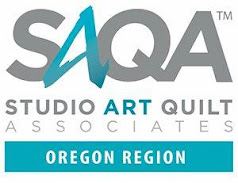On June 10th guild members gathered for the final meeting of this season. We will resume meeting on September 9th.
Our program focused on viewing the Studio Art Quilt Associates, Oregon Regional Group's trunk show, Common Threads: The Stitches that Unite Us. Here is a little information about the Oregon Regional group of SAQA:
SAQA is dedicated to promoting the art quilt and the artists who create them. Whether you're an artist, a collector, or enthusiast, we can offer you inspiration and resources to support your passion for art quilts. Join our dynamic creative community and help make the art quilt universally recognized as a fine art medium!
More information can be found at https://https://www.saqa.com.
For tonight's program, four members gathered at each table, studying 5 of the little 7" by 10" quilts. After viewing each set of 5 quilts, the quilt set was passed to the next table, rotating until all members had viewed all 30 of the quilts. It was fascinating to read the descriptions of the materials and techniques the artists used to create the quilts. The trunk show also included 5 of the SAQA Global Exhibition catalogs containing the work of themed international juried exhibitions. Catalogs of the global exhibitions can be purchased at https://www.saqa.com/online-store


































